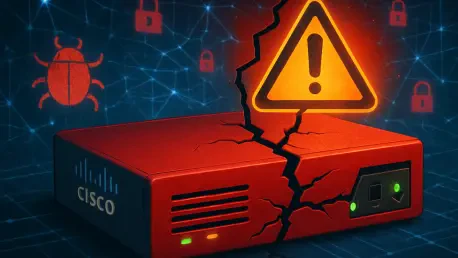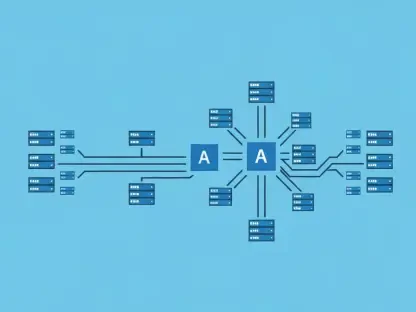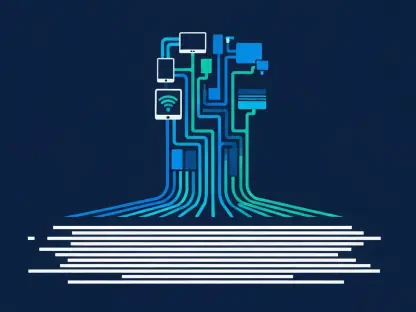In an era where cybersecurity threats loom larger than ever, a recent disclosure by Cisco has sent shockwaves through the tech and security communities, highlighting a severe flaw in its Secure Firewall Management Center (FMC) software. Identified as CVE-2025-20265, this remote code execution (RCE) vulnerability has earned a CVSS severity score of 10.0, marking it as a top-tier risk that demands immediate attention. This critical issue, found in specific versions of the software when RADIUS authentication is enabled, opens the door for attackers to execute arbitrary shell commands with elevated privileges, potentially compromising entire systems. The urgency of addressing this flaw cannot be overstated, as it underscores the fragility of even the most trusted security tools in the face of evolving cyber threats. As organizations worldwide rely on Cisco’s solutions to safeguard their networks, the implications of this vulnerability raise pressing questions about the safety of digital infrastructure and the speed of response required to mitigate such risks.
Unpacking the Severity of the Flaw
A deeper examination of CVE-2025-20265 reveals why this vulnerability is considered catastrophic for users of Cisco’s Secure Firewall Management Center software, specifically versions 7.0.7 and 7.7.0. The flaw arises from improper handling of user input during the RADIUS authentication process, a protocol widely used for secure network access and credential verification. By submitting specially crafted input, an attacker can exploit this weakness to gain unauthorized access and execute commands with high-level privileges on the affected device. Such a breach could lead to complete system compromise, exposing sensitive data and critical operations to malicious actors. The CVSS score of 10.0 reflects not only the ease of exploitation but also the devastating potential impact, making it clear that no organization using the affected software can afford to ignore this issue. This situation serves as a stark reminder of how even small oversights in software design can create gaping security holes.
Beyond the technical details, the broader implications of this vulnerability paint a troubling picture for cybersecurity at large. With Cisco’s firewall solutions deployed across countless enterprises, government agencies, and critical infrastructure sectors, the risk of widespread exploitation is alarmingly high if patches are not applied swiftly. An attacker gaining control over a firewall management system could manipulate security policies, disable protections, or use the compromised device as a gateway to deeper network infiltration. This vulnerability is not just a technical glitch but a potential catalyst for large-scale breaches that could disrupt operations or lead to data theft on a massive scale. The fact that exploitation requires only RADIUS authentication to be enabled—a common configuration in many networks—further amplifies the danger, as it lowers the barrier for attackers to succeed. Immediate awareness and action are essential to prevent this flaw from becoming a cornerstone of major cyber incidents.
Cisco’s Response and Mitigation Strategies
In response to the discovery of CVE-2025-20265, Cisco has acted promptly by releasing a security advisory and offering a complimentary software update to address the critical flaw in its FMC software. Customers with active service agreements can access this update through standard channels, and the company has strongly urged immediate application to prevent potential exploitation. However, a significant challenge lies in the absence of direct workarounds to fully bypass the vulnerability. As a temporary measure, Cisco recommends switching to alternative authentication methods, such as local user accounts, external LDAP authentication, or SAML single sign-on (SSO), to minimize exposure since the flaw is tied specifically to RADIUS configurations. While this stopgap can reduce risk, it may not be feasible for all organizations, especially those with complex network setups reliant on RADIUS, highlighting the urgency of deploying the official patch.
Further scrutiny of Cisco’s approach reveals a proactive stance, yet it also underscores the limitations faced by both the vendor and its customers in addressing such high-severity issues. The release of the update is a critical step, but the process of applying patches across large, distributed systems can be time-consuming and fraught with logistical challenges. Many organizations may struggle with downtime concerns or compatibility issues, delaying remediation efforts. Additionally, the advisory is part of a larger set of 21 security notices covering 29 vulnerabilities across multiple Cisco products, indicating a broader pattern of security concerns that require sustained attention. For users, the temporary shift to alternative authentication methods might introduce operational friction or require additional training, adding layers of complexity to an already urgent situation. This scenario emphasizes the need for robust patch management strategies and contingency planning to navigate such critical vulnerabilities effectively.
Broader Context of Cisco Security Challenges
The disclosure of CVE-2025-20265 does not exist in isolation but rather fits into a troubling trend of security challenges faced by Cisco across its product portfolio. Earlier this year, other significant vulnerabilities were reported, including issues in Cisco Identity Services Engine (ISE) Software added to the US Cybersecurity and Infrastructure Security Agency (CISA) Known Exploited Vulnerabilities (KEV) catalog, signaling active exploitation risks. Additionally, incidents like the exploitation of Cisco devices by a state-sponsored group using a custom tool underscore the persistent targeting of Cisco infrastructure by sophisticated threat actors. These recurring issues highlight the growing cybersecurity risks in an industry where networking and security software are prime targets for attackers seeking to disrupt or infiltrate critical systems, reinforcing the importance of vigilance beyond a single flaw.
Looking at the larger landscape, the frequency of such vulnerabilities suggests that Cisco users must adopt a proactive, multi-layered approach to security rather than relying solely on vendor-provided fixes. The involvement of agencies like CISA, which mandates swift action on critical flaws especially for federal entities, adds external pressure to ensure compliance and protection. This dynamic illustrates a shared responsibility between Cisco, its customers, and regulatory bodies to safeguard digital infrastructure. The pattern of exploits also points to an escalating threat environment where state-sponsored and criminal actors alike are increasingly adept at identifying and weaponizing software weaknesses. For organizations, this means that staying ahead of threats requires not only rapid response to advisories but also investment in threat intelligence, regular audits, and employee training to mitigate human error as a potential entry point for attacks.
Moving Forward with Enhanced Protections
Reflecting on the response to CVE-2025-20265, it became evident that swift action was paramount in preventing widespread exploitation of Cisco’s FMC software vulnerability. Organizations that prioritized the application of the provided software update managed to close the critical gap before attackers could capitalize on it. The temporary adoption of alternative authentication methods by many also proved effective in reducing immediate risks, showcasing the value of adaptive strategies in crisis moments. Cisco’s transparency in issuing detailed advisories alongside the patch played a crucial role in guiding users through the mitigation process, setting a benchmark for vendor accountability in addressing high-severity flaws.
As a path forward, organizations should focus on building resilience through comprehensive security frameworks that anticipate and address vulnerabilities before they escalate. Implementing automated patch management systems can streamline the update process, minimizing delays and human oversight. Regular security assessments and penetration testing should become standard practice to identify potential weaknesses proactively. Collaboration with industry peers and regulatory bodies can also enhance threat intelligence sharing, ensuring a collective defense against evolving cyber risks. By integrating these measures, the lessons learned from this incident can drive stronger protections, safeguarding networks against the next wave of challenges in an ever-shifting threat landscape.









